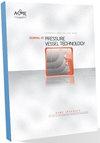Faster Rstreng: A More Efficient Effective Area Method Algorithm For Corrosion Assessment
IF 1.4
4区 工程技术
Q4 ENGINEERING, MECHANICAL
Journal of Pressure Vessel Technology-Transactions of the Asme
Pub Date : 2023-02-16
DOI:10.1115/1.4056932
引用次数: 0
Abstract
Corrosion is one of the major threats to the safety and structural integrity of oil and gas transmission pipelines. The corrosion threat is usually managed by regular in-line inspection (ILI). The effective area method (RSTRENG) is the most popular corrosion assessment model to convert the measured corrosion size to predicted burst pressure. Given a detailed corrosion measurement profile, the effective area method involves an iterative process to find the minimum burst pressure. As stated in ASME B31G, “for a corroded profile defined by n measurements of depth of corrosion including the end points at nominally full wall thickness, n!/2(n - 2)! iterations are required to examine all possible combinations of local metal loss with respect to surrounding remaining material”, the widely used effective area algorithm has at least an order of n-square time complexity (O(n2)). As n increases, the computation time increases nonlinearly. This paper reviewed the traditional RSTRENG algorithm first, and demonstrated that it is not necessary to always loop through all the combinations and check the corresponding burst pressure one by one. Because some combinations with shallower and shorter corrosion size are certainly not the final critical combination corresponding to the minimum burst pressure. A more efficient algorithm (Faster RSTRENG) is proposed and presented in this paper, which can reduce the algorithm computation time significantly.更快的强度:一种更有效的腐蚀评估面积法算法
腐蚀是对油气输送管道安全和结构完整性的主要威胁之一。腐蚀威胁通常通过定期在线检测(ILI)进行管理。有效面积法(RSTRENG)是最流行的腐蚀评估模型,用于将测量的腐蚀尺寸转换为预测的爆破压力。给定详细的腐蚀测量剖面,有效面积法包括一个迭代过程,以找到最小爆破压力。如ASME B31G所述,“对于由n次腐蚀深度测量(包括标称全壁厚的终点)定义的腐蚀剖面,需要n!/2(n-2)!次迭代来检查与周围剩余材料相关的局部金属损失的所有可能组合”,广泛使用的有效面积算法具有至少n次方时间复杂度(O(n2))。随着n的增加,计算时间非线性地增加。本文首先回顾了传统的RSTRENG算法,并证明了不必总是遍历所有组合并逐一检查相应的爆破压力。因为一些腐蚀尺寸较浅和较短的组合肯定不是与最小爆破压力相对应的最终临界组合。本文提出了一种更有效的算法(Faster RSTRENG),它可以显著减少算法的计算时间。
本文章由计算机程序翻译,如有差异,请以英文原文为准。
求助全文
约1分钟内获得全文
求助全文
来源期刊
CiteScore
2.10
自引率
10.00%
发文量
77
审稿时长
4.2 months
期刊介绍:
The Journal of Pressure Vessel Technology is the premier publication for the highest-quality research and interpretive reports on the design, analysis, materials, fabrication, construction, inspection, operation, and failure prevention of pressure vessels, piping, pipelines, power and heating boilers, heat exchangers, reaction vessels, pumps, valves, and other pressure and temperature-bearing components, as well as the nondestructive evaluation of critical components in mechanical engineering applications. Not only does the Journal cover all topics dealing with the design and analysis of pressure vessels, piping, and components, but it also contains discussions of their related codes and standards.
Applicable pressure technology areas of interest include: Dynamic and seismic analysis; Equipment qualification; Fabrication; Welding processes and integrity; Operation of vessels and piping; Fatigue and fracture prediction; Finite and boundary element methods; Fluid-structure interaction; High pressure engineering; Elevated temperature analysis and design; Inelastic analysis; Life extension; Lifeline earthquake engineering; PVP materials and their property databases; NDE; safety and reliability; Verification and qualification of software.

 求助内容:
求助内容: 应助结果提醒方式:
应助结果提醒方式:


